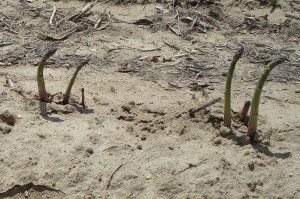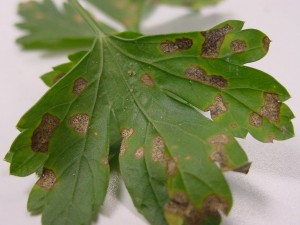At the request of the NJ Dept of Agriculture, DEP Commissioner Martin today approved open burning and the use of smudge pots for tonight and Friday because of the extreme cold temperatures forecasted for those evenings. This approval mirrors the approval from 2012. Copies of the approval and restriction memo plus the list of Critical Temperatures for Frost Protection of Various Crops are attached.
Vegetable Crops Edition
Seasonal updates and alerts on insects, diseases, and weeds impacting vegetable crops. New Jersey Commercial Vegetable Production Recommendations updates between annual publication issues are included.
Subscriptions are available via EMAIL and RSS.
Quick Links:
 NJ Commercial Vegetable Production Recommendations
NJ Commercial Vegetable Production Recommendations
 Rutgers Weather Forecasting - Meteorological Information important to commercial agriculture.
Rutgers Weather Forecasting - Meteorological Information important to commercial agriculture.
Damping-off: Important Early-season Pathogens
It is extremely important to know which pathogen is causing damping-off problems and which fungicide to properly apply. The key to controlling damping-off is being proactive instead of reactive. Always refer to the fungicide label for crop use, pathogens controlled, and application rates.
Damping-off is caused by a number of important vegetable pathogens and is very common during the spring. Damping-off can kill seedlings before they break the soil line (pre-emergent damping-off) or kill seedlings soon after they emerge (post-emergent damping-off). Common pathogens that cause damping-off include Pythium, Phytophthora, Rhizoctonia and Fusarium spp.
Control of damping-off depends on a number of factors. First, is recognizing the conditions which may be leading to the problem (i.e., weather/greenhouse growing conditions) and second, identifying the pathogen causing the problem.
Conditions Favoring Damping-off
Although all four pathogens are associated with damping-off, the conditions which favor their development are very different. In general, Phytophthora and Pythium are more likely to cause damping-off in cool, wet or overwatered soils that aren’t allowed to dry out due to cloudy weather or cooler temperatures. Conversely, Rhizoctonia and Fusarium are more likely to cause damping-off under warmer, drier conditions especially if plug trays are kept on the dry side to help reduce transplant growth. [Read more…]
Controlling Septoria Leaf Spot in Parsley
Septoria leaf spot in parsley can cause significant losses in fields where it has become established. Like other Septoria’s, the leaf spots produced on parsley look much like the leaf spots produced on tomatoes and other crops.
Parsley growers who have significant septoria leaf spot issues every year and have seen poor control in fields where FRAC code 11 fungicides have been used considerable in the past should consider no longer using them due to potential resistance issues. Fungicide programs should include Fontelis at a high rate (16.0 to 24.0 fl oz/A) tank mixed with a copper rotated on a weekly basis with Merivon (5.5 fl oz) plus copper. Fontelis has a 3 day PHI and a 72.0 fl. oz season max. Merivon has a 1 day PHI and 33.0 fl. oz season max. Organic farmers should use an OMRI-approved copper fungicide on a regular basis to help suppress septoria leaf spot.
Growers Guide to Protectant Fungicides
(FRAC groups M1 – M11)
Protectant (contact) fungicides, such as the inorganics (copper, FRAC group M1) and sulfur (FRAC code M2); the dithiocarbamates (mancozeb, M3), phthalimides (Captan, M4), and chloronitriles (chlorothalonil, M5) are fungicides which have a low chance for fungicide resistance to develop. Protectant fungicides typically offer broad spectrum control for many different pathogens.
Why wouldn’t fungi develop resistance to protectant fungicides? Protectant fungicides are used all the time, often in a weekly manner throughout much of the growing season.
Spear Damage in Asparagus
Spear damage in asparagus can be caused by diseases such as Phytophthora spear and crown rot and purple spot. However, other environmental factors during the spring can damage spears as they emerge from the soil.
 Fig. 1. Wind damage of asparagus spears. Notice how all spears are pointed in the same direction |
Wind – Periods of heavy winds during emergence will cause spears to bend.Winds can cause one side of the spear to dry out quicker than the other causing the spear to bend and point in the direction of the prevailing wind. An asparagus planting is suffering from wind damage if most of the bent spear heads in the bed are pointing in the same direction (Fig.1). |
Vegetable Disease Briefs – 4/22/15
- Quadris 2F from Syngenta, the first strobilurin (FRAC group 11) fungicide on the market, is coming off patent and a number of companies are expected to apply to manufacture and sell is under another name. Thus, in the 2015 Vegetable Recommendations Guide you will see references to Quadris (FRAC group 11) switched to azoxystrobin (FRAC group 11) much like we did with changing Bravo WeatherStik (M5) to chlorothalonil a few years ago. As more FRAC group 11 fungicides come off patent in the next few years we expect to do the same.
- Cucurbit downy mildew is presently active on acorn, butternut, yellow summer, cucumber, cantaloupe, and giant pumpkin in southern Florida. To track the progress of cucurbit downy mildew in the US please visit (http://cdm.ipmpipe.org/)
- Basil downy mildew is active in southern Florida.

